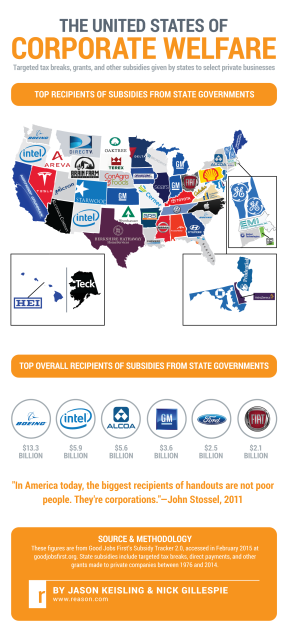Tim Worstall isn’t impressed with a recent report that claims traditional energy companies (oil, gas, and coal) get government subsidies that amount to $88 billion per year, just from the G20 countries:
The report itself is here. Have a look at it yourselves, by all means, but here’s the three things they’ve added up to get to that $88 billion figure:
A fossil fuel subsidy is any government action that lowers the cost of production, lowers the cost of consumption, or raises the price received by producers of fossil fuels. Types of fossil fuel subsidies include financial contributions or other support from the government, such as grants and direct payments, tax concessions, non-market investments made as a result of government ownership of fossil fuel companies, in-kind support (including specific infrastructure), credit support (loans and loan guarantees), insurance and indemnification, market price support, procurement, and responsibility for decommissioning (Koplow and Charles, 2010; Steenblik, 2008). This report divides ‘exploration subsidies’ into three categories:
• ‘national subsidies’, such as tax breaks to companies and direct spending by government agencies
• ‘investment by SOEs and
• ‘public financing’ including support from domestic, bilateral and multilateral international (e.g. loans, equity, and guarantees)
To take that second one first, SOEs are state owned enterprises. So when Rosneft spends money on drilling a new well, given that Rosneft is largely state owned (and most certainly closely state connected) then this is a government subsidy to fossil fuel exploration. No, this isn’t normally what we mean by a subsidy and shouldn’t be counted as one. Just that one classification error accounts for up to half of their $88 billion. Just to repeat the error: claiming that investment by a state owned company on purely commercial terms is a subsidy simply isn’t true. If Statoil drills a new well, upon which it makes the usual profits and finances it in the normal manner, this is not a state subsidy. Yet this report is trying to claim that it is.
The public financing part is a bit of a stretch to be honest. The claim is that if the World Bank lends money to open a coal mine in some poor country then that’s a subsidy from the rich countries (who subsidise the World Bank) to fossil fuels. You could, I suppose, make that case but it is very much a stretch. And if you were to make that case then the subsidy would be only the difference between commercial lending terms on that mine and the concessionary terms that the World Bank is offering. Which isn’t what they measure at all.
But the real problem is with their insistence that any tax break is a subsidy. In their estimates of tax breaks they include things that any normal company gets it’s just that given the differences in the extractive industries we tend to give them different names. Every company is, for example, able to write off the cost of R&D against future income. Drilling or surveying is a form of R&D but we just have a slightly different set of names for how fossil fuel companies can write off those costs. To include all of those “tax breaks” as subsidies when they’re on offer, in slightly different forms and slightly different names, to all producers of anything is not quite being accurate.
Update: In a post today, he revisits the subsidies argument.
Here’s one report on what the IEA is saying:
Fossil fuels are reaping $550 billion a year in subsidies and holding back investment in cleaner forms of energy, the International Energy Agency said.
Oil, coal and gas received more than four times the $120 billion paid out in incentives for renewables including wind, solar and biofuels, the Paris-based institution said today in its annual World Energy Outlook.
Yes, all of that is entirely true. And it’s also true, as the IEA has said in the past, that we really would like to stop those subsidies to fossil fuels. On three grounds, the first that they’re very inefficient, the second that they don’t actually reach the poor they’re aimed at and the third that removing them would take us a long way to meeting our climate change targets.
However, nothing is ever that simple: and the big point to note here is that it really isn’t us in the rich countries that are subsidising fossil fuels.
[…]
There’s our two numbers, the renewables subsidy and the fossil fuel one. And yes it’s entirely true that we’d like to reduce that second, the fossil fuel one. Either so we can increase the renewables one because we have more money or so we can decrease it as we now longer have two policies working in opposition to each other.
However, here’s the thing for public policy. It’s us in the rich countries, largely so at least, who are subsidising the renewables. Great, that’s under our control. But it’s almost entirely not us in the rich countries subsidising the fossil fuels. That means, absent the reintroduction of colonialism, that those subsidies are not something under our control.
We should also note that these are “real subsidies”. These aren’t games being played with statistics as yesterday’s attempt to persuade us that we do subsidise by $88 billion. We’re not including tax breaks, not totting up R&D allowances or anything. This really is $550 billion in cash being spent by governments to subsidise fossil fuels.




